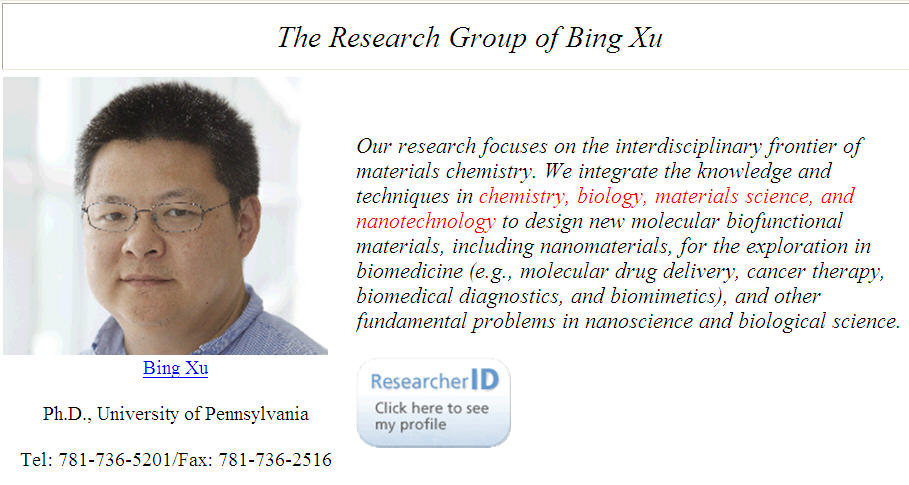博文
看看南京大学校友徐兵(Bing Xu)教授的新作(修改稿)
|||
看看南京大学校友徐兵(Bing Xu)教授的新作
诸平

徐兵教授早年毕业于南京大学,他在南京大学获得学士、硕士学位之后去了美国。1996年在美国宾夕法尼亚大学(Universityof Pennsylvania)获得博士学位,1996~1997在美国麻省理工学院(Massachusetts Institute of Technology)从事博士后研究,但是随后又转移到哈佛大学(Harvard University,1997~2000)继续从事博士后研究。2000年8月,徐兵作为一名助理教授进入香港科技大学(Hong Kong University of Science & Technology),2006年元月被聘为副教授,2008年8月被聘为教授,同年9月他又以副教授的头衔进入美国布兰迪斯大学(Brandeis University) ,该大学是位于美国马赛诸塞州波士顿地区沃尔瑟姆镇的一所颇具实力的私立综合性大学,2009年11月,徐兵被聘任为教授。
徐兵博士曾经获得多个奖项,如2008年获得了人类前沿科学项目奖(Human Frontier ScienceProgram Award 2008)、2007年先后获得卓越讲师职务奖(DistinguishedLectureship Award 2007)、日本化学会亚洲国际研讨会奖(CSJ Asian International Symposium 2007)以及日本化学学会奖(Chemical Society of Japan 2007),2001年获得杜邦公司亚欧年轻研究者奖(DuPont Asian &European Young Investigator Award 2001),1997年获得美国国立卫生研究院博士后奖学金(NIH Postdoctoral Fellowship 1997)、1996年获得国际液晶学会格伦·布朗奖(Glenn Brown Award of International Liquid Crystal Society 1996)。目前徐兵教授是多个期刊的编委。他的研究领域包括材料化学、生物功能材料、高分子化学和表面化学、生物医学功能分子和纳米材料。他有上百篇学术论文在SCI收录期刊上发表,最近在Bioconjugate Chem. 杂志上发表的论文,《化学与工程新闻》(C&EN)周刊有专文介绍,谷歌学术搜索结果(被引频次>100)摘录如下,供大家参考。
C&EN, Latest News
Web Date: May 19, 2014Self-Assembling Molecule Nurtures Stem Cells
News Channels: Biological SCENE, Materials SCENE
Keywords: glycoconjugate, embryonic stem cell, supramolecular assembly, hydrogel

Our cells live in a carbohydrate jungle. In particular, stem cells interact with a forest full of sugars, which trigger how they grow and differentiate. But when scientists grow stem cells in the lab, the culture medium provides a vastly different environment. To replicate the cells’ native surroundings, researchers constructed a sugar-decorated molecule that self-assembles into a hydrogel that mimics the extracellular matrix (Bioconjugate Chem. 2014, DOI: 10.1021/bc500187m). The gel encourages mouse embryonic stem cells to grow and zygotes to develop into blastocysts, suggesting the molecule someday could help grow human tissue in the lab, the researcher say.
The extracellular matrix that cells sit in is a complex mixture of proteins and sugar molecules. Molecules on the surface of stem cells, often sugars themselves, interact with this matrix in ways that are critical to stem cell differentiation and development, says Bing Xu of Brandeis University.
For more than a decade, Xu has been developing supramolecular assemblies, molecules that bind together to create materials with new and desirable properties. Xu hypothesized that a supramolecular assembly generated from a glycoconjugate—a carbohydrate molecule covalently linked to other molecules—might recreate the molecular environment of the extracellular matrix and facilitate stem cell growth.
To create the glycoconjugate, the researchers stitched together a sugar called glucosamine, the nucleobase adenine, and a string of four amino acids. To help encourage interactions between the molecule and cells, they chose an amino-acid sequence known to interact with integrins, proteins that coat the surface of stem cells and coordinate cell-to-cell interactions. The team decided to include adenine because previous work showed that the nucleobase promotes self-assembly. Using static light scattering, the researchers studied gels formed by different concentrations of the glycoconjugate in buffer and found that the assembly formed nanofibers and clusters of particles with structures that slightly resembled that of amyloid fibrils, Xu says.
Xu’s team grew mouse embryonic stem cells on media containing the glycoconjugate gel. After 48 hours, they counted twice as many cells in the culture with 200 μM glycoconjugate than in a culture without it. In another experiment, the researchers found that 84% of mouse zygotes grown in 500 μM glycoconjugate developed into blastocysts after four days compared to 31% in a glycoconjugate-free growth medium.
The researchers next want to understand how the glycoconjugate promotes stem cell growth, in particular which proteins are involved.
The ability of these supramolecular assemblies to trigger activity in stem cells is exciting, says Brian K. Shoichet of the University of California, San Francisco. “People should be aware of this work.” He wonders whether it would be possible to tweak the design of the self-assembling molecules to direct stem cells to differentiate in a particular way.

https://blog.sciencenet.cn/blog-212210-795926.html
上一篇:炸药检测新技术:廉价试纸检测炸药只需几秒钟(附原文)
下一篇:抗癌药TIC10结构今非昔比,所有权拉锯战结果难预料